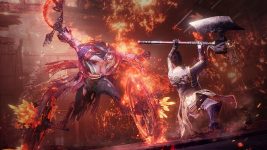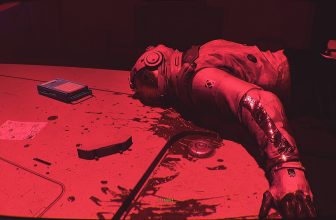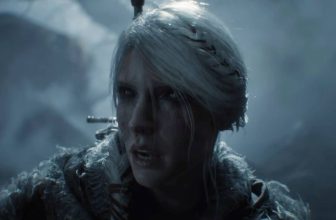As I sit in a darkened room, taking near-endless punishment from a four hour build of Nioh 3, It’s easy to forget that Soulslikes were once utter garbage. As Dark Souls fever swept the land in the 2010s, developers across the globe scrambled to cash in with their own off brand alternatives. CI Games borked it with 2014’s shonky Lords of the Fallen. Deck 13 Interactive added a so-so sci-fi twist with The Surge, yet despite their best efforts, the first wave of Soulslikes felt like pale imitators, failing to capture that FromSoftware magic. Then Nioh came along.
Renowned for creating the hard as nails Ninja Gaiden series, Nioh developer Team Ninja were the perfect fit. “Soulslike – that’s the first time I’ve heard that word,” jokes Fumihiko Yasuda Nioh 3 general producer and head of Team Ninja, “yes, we’re all big fans of Dark Souls at Team Ninja.”
Out of darkness

No stranger to crafting compellingly-masochistic action, Nioh was the game that finally won over FromSoft fans, paving the way for other developers to build soulslikes that carved their own path out from under Dark Souls’ shadow.
Key info
Developer: Team Ninja
Publisher: Koei Tecmo
Platform(s): PC, PS5
Release date: February 6, 2025
“We’re known for our sense of action and the speediness of action – you see it in the Ninja Gaiden series and the Dead or Alive series. [It’s why] I think we have our own unique approach in our Nioh series,” explains Nioh 3 producer Kohei Shibata. “We’re able to make a Soulslike with action elements and elements of hack and slash, [which] I think makes Nioh unique, and hopefully pushes the genre forward.”
It’s this trademark sense of speed that feels immediately tangible in Nioh 3. As I sprint across a burning, demon-infested Kyoto, my custom built character fires off attacks with pleasingly character-action panache. As I carve up hordes of yokai and slice up samurai at a break neck pace, its combat feels closer to Devil May Cry 5 than Sekiro – and that’s largely down to major new mechanic.

In an Assassin’s Creed Shadows-esque touch, Nioh 3 lets you play both as a samurai and a ninja. Yet instead of locking you into each role across two characters like in AC Shadows, Nioh 3 protagonist Tokugawa can transform into either discipline at the tap of a button, letting players transition from a brutal samurai katana blow into a flurry of fast paced ninja swipes in the same combo.
There’s a wholeheartedly PS2-era energy coursing through Nioh 3 – and I’m not just referring to its utterly honking English voice acting. While Nioh 3 is a mixed bag visually, there’s a stylish swagger to attack animations and the way that combat plays out on screen, imbuing the serious Soulslike with an arcade-y energy. It’s something the duo tells me was inspired by their recent collaboration with Platinum Games, who developed Ninja Gaiden 4.

“Platinum Games and Team Ninja both make action games, but I think we were able to see that the way that they think and approach [the genre] is different,” reflects Yasuda. “With Platinum Games, their strength is in a very flashy, emotive kind of action, and after seeing that incorporated into Ninja Gaiden 4 [that had] a bit of influence on the visual production and action in Nioh 3.”
“We learnt from their production style as well,” continues Yasuda, “at Team Ninja we would really look at things in very specific parts whereas Platinum’s strengths are in the way that they look at the overall action.”
Another big change for Nioh’s third entry is in the scale of its environments. Despite trailers suggesting that Nioh 3 will be an open world game, levels feel closer to being dropped into a Monster Hunter map. Describing each environment as “open field”, players are free to roam sizable but fairly contained sandboxes, segueing from crumbling ancient temples to treacherous mountaintops. In another nod to Assassin’s Creed, these newly open environments will be littered with bases to clear out, with each new map hiding a smattering of needy NPCs asking for help with optional side quests.

Thanks to an impressively deep character creator, you can completely change the look of both ninja and samurai.
Put in the flowing robes of a young warrior named Tokugawa Takechiyo, as a portal into Hell infests Japan with demons, Tokugawa finds their quest to become the Shogun of Japan suddenly put on hold. Having a fixed character separates Nioh 3 from many of its Soulslike peers, yet Team Ninja has ensured that no two players will look the same. Thanks to an impressively deep character creator, you can completely change the look of both ninja and samurai, letting your version of Tokugawa transform into a completely different looking person at the tap of a button.
One way in which Nioh 3 has borrowed from Sekiro is in its newfound focus on parrying. Once an enemy glows red you can trigger Burst attacks, a special move that cancels your enemy’s attack and reduces their maximum Ki, allowing you to go ham on them.
Fighting history

As in Onimusha: Way Of The Sword, Nioh fuses Japanese history with fantastical horror elements, and now with Onimusha returning after a 20 year absence, the two historical horror samurai epics are launching just months apart.
“We are looking forward to the new Onimusha game,” smiles Yasuda. “In terms of samurai action with yokai elements, that was probably the first title that really brought that into the game genre, but Onimusha is where modern Ninja Gaiden came from. So it’s like the cycle of history is now repeating itself, where one is coming out after the other. “
Yet it’s not just gaming history that Nioh finds itself cemented in, with Nioh featured in an upcoming ‘Samurai’ exhibition at the British Museum next February, alongside games like Assiassin’s Shadows and the Nobunaga’s Ambition series.
While Nioh may be in a museum depicting armour in the sengoku period, its place in gaming history is still in motion. Almost a decade after Nioh first offered a viable alternative to FromSoft, high quality Soulslikes are now the norm.

Despite Team Ninja competing in an increasingly crowded space, Shibata feels that Nioh’s inherent layer of accessibility will help this series continue to stand out. “Even though there’s a high difficulty level, I think there is a fairness in the way that you can approach defeating the enemies that we’re incorporating into our games,” says Shibata. “We always want to ensure that the controls feel really good and responsive, and that the better you get, the better response you get on screen as well.”
It’s a philosophy that Team Ninja are even more determined to imbue following the recent untimely passing of game designer and Team Ninja exec Tomonobu Itagaki. “We want the player to have a rich experience of mastery through action games,” says Shibata. “This was instilled in me from Tomonobu Itagaki, and something that I treasure and am determined to continue. “







